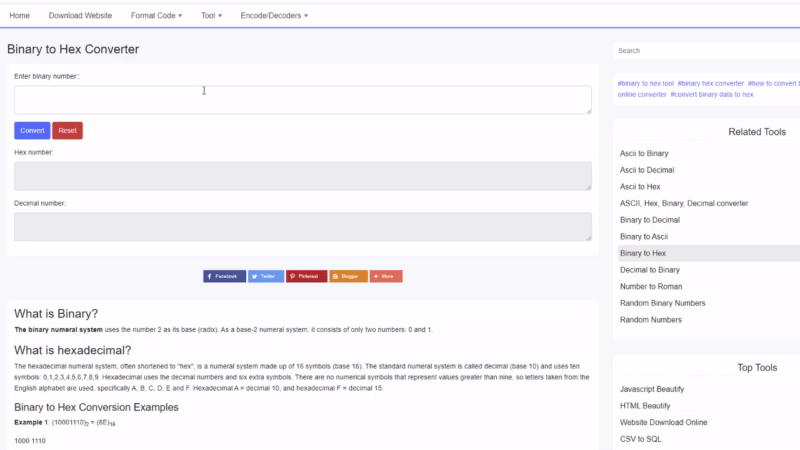What is Binary?
The binary numeral system uses the number 2 as its base (radix). As a base-2 numeral system, it consists of only two numbers: 0 and 1.
What is hexadecimal?
The hexadecimal numeral system, often shortened to "hex", is a numeral system made up of 16 symbols (base 16). The standard numeral system is called decimal (base 10) and uses ten symbols: 0,1,2,3,4,5,6,7,8,9. Hexadecimal uses the decimal numbers and six extra symbols. There are no numerical symbols that represent values greater than nine, so letters taken from the English alphabet are used, specifically A, B, C, D, E and F. Hexadecimal A = decimal 10, and hexadecimal F = decimal 15.
Binary to Hex Conversion Examples
Example 1: (10001110)2 = (8E)16
1000 1110
8421 8421
8000 8420
8 15
8 E
Example 2: (111011.111)2 = (3B.E)16
(Notice that this binary number has a decimal point and cannot be automatically grouped in sets of four. You need to add 0’s both the leftmost and the rightmost parts.)
0011 1011. 1110
8421 8421 8421
0021 8021 8420
3 11. 14
3 B. E
Binary to Hex conversion table
| Binary Number | Decimal Number | Hex Number |
|---|---|---|
| 0 | 0 | 0 |
| 1 | 1 | 1 |
| 10 | 2 | 2 |
| 11 | 3 | 3 |
| 100 | 4 | 4 |
| 101 | 5 | 5 |
| 110 | 6 | 6 |
| 111 | 7 | 7 |
| 1000 | 8 | 8 |
| 1001 | 9 | 9 |
| 1010 | 10 | A |
| 1011 | 11 | B |
| 1100 | 12 | C |
| 1101 | 13 | D |
| 1110 | 14 | E |
| 1111 | 15 | F |
| 10000 | 16 | 10 |
| 10001 | 17 | 11 |
| 10010 | 18 | 12 |
| 10011 | 19 | 13 |
| 10100 | 20 | 14 |
| 10101 | 21 | 15 |
| 10110 | 22 | 16 |
| 10111 | 23 | 17 |
| 11000 | 24 | 18 |
| 11001 | 25 | 19 |
| 11010 | 26 | 1A |
| 11011 | 27 | 1B |
| 11100 | 28 | 1C |
| 11101 | 29 | 1D |
| 11110 | 30 | 1E |
| 11111 | 31 | 1F |
| 100000 | 32 | 20 |
| 1000000 | 64 | 40 |
| 10000000 | 128 | 80 |
| 100000000 | 256 | 100 |
